Art is an expression of human creativity in pleasure. It varies from individual to individual and people to people while; presenting diversity of expressions in media as such presentation depends on; the mood and the imagination of the artist. Of course by art, we mean the depiction of figures and designs on different materials, which are useful to human society and related to its behavior. The medium of art may be many and the natural objects may either remain as they were or fashioned to hold the design. As the art forms vary from people to people, we find the homogenous groups exhibiting their designs that reveal the traditional patterns followed by them. This aspect is more prominently present in the tribal cultures and Orissa is no exception to it. Despite outside influences, one can not miss to find the uniqueness of their indigenous cultural traits present prominently or recessively.
The rings and anklets constitute the repertoire of the ornaments where art patterns of the Juangs are found carved. Juangs are a dance loving people. They wear rings, anklets and bangles to make the dance look beautiful and musical. Naturally the shape of these these ornaments are such that they fit rightly to the dancers' limbs. The Juang women also use these ornaments to decorate their person even beyond the dancing hours.
Rings:
A total number of twenty-two samples of rings have been examined out of which twelve pieces belong to wire type of rings and the rest ten belong to solid-flat type. In the wire type of rings one finds different number of circular wires attached at the top with some patterns either plated or otherwise. Out of twelve pieces of wire type of rings, there are six number of rings having two circular wires, two rings with three circular wires and four rings with four circular wires.
| Type-I ---
This type of rings having two circular wires are locally called ‘Jhumkc Mudi’ wherein the strings or wire-circles are attached with Jhumkas or small bells. The Jhumakas are tiny hollow balls having a little opening towards the end not attached to the wire. Inside these hollow balls are kept silica grains or other particles to produce sound during dance performances. These hollow balls are proportionately rounded or swelled with circular lines carved at interval, parallel to each other towards the apex of the convex body of both the faces. The apexes are provided with single dot protuberances or knobs on both the sides.
|
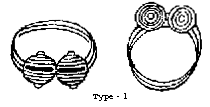 |
 |
Type-II ---
This type of rings with double circular wires, however, are not attached to a Jhumka. But they have different types of tops. There are three such rings with two flat circular plates attached to each on the wires giving a projecting design towards sides. The tops are carved with concentric lines on each giving a fine look but not causing any harm to finger while dancing. This design is to be found both at upper and inner portions of these flat plates of circular shape.
|
|
Type-III --- There is another ring having double circular-wires but the top attachment is a developed form of the previous type. The top is an elongated plate with S-letter type of line carved on it with concentric circular forms at both the ends wherein three projecting dots are designed to give it a decorative look.
|
 |
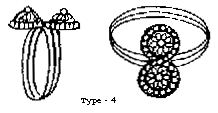 |
Type-IV ---
There is another type of ring of the double-wire type. Its top is on a plate decorated with two flowers shown lying side by side. The flowers carved exhibit three parallel circular lines drawn one inside the other. The outer two circles are apportioned with equidistanced short lines joining the two. The inner circler contains a knobbed centre encircled by projected dotted designs.
|
| Type-V
--- Another ring having three-wire attachments again contain four such circular flat plates attached to each other at the top providing a plat-form like design. At the center of these plates is seen a small projecting knob. These plates are again to be seen with similar concentric lines with a central knob in each. The reverse sides of these plates also contain similar concentric lines with central knobs.The three are seen fused together though discernible separately.
|
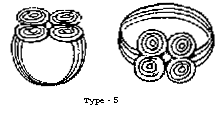 |
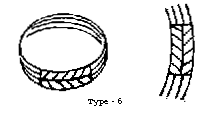 |
Type-VI ---
There is found another ring with three strings of circular make attached to each other but without any top attachments and the top is seen modified into a flat-plate type with herring-bone design carved on it inside a rectangle bordering the design.
|
| Type-VII ---
The four-wire ring types have also variations. The first type is seen with its top modified into a plate type though the wires are to be seen fused together but discernible separately. There are two such rings. The plated top is seen again with herring-bone design inside a rectangle bordering the design. Again, this design is seen in-set in another rectangle drawn parallel to the previous rectangle at its outside through both the ends are to be seen made one with both the ends of the previous rectangle.
|
 |
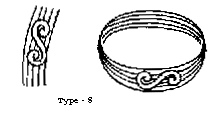 |
Type-VIII ---
The second four-wired ring is without fusing of the wires but lying close to each other. The top attachment is seen with a design of English ‘S’ letter with both its ends moulded into concentric rounds.
|
| Type-IX ---
there are two more rings with four-wire provision without the wires fused together. The top of these rings are designed in a flower pattern with two layer of petals one super-imposed on the first and top projecting knob type of bud. The upper layer of the petals are smaller than the first in length design to give a flower pattern. There are another set of rings numbering ten made of brass and could be separated in six groups. All these rings are single-circled and thick in their make and quite different from the wired-typed.
|
 |
 |
Type-X ---
the first group contain three numbers of rings. But these rings can be sub-grouped into two. In the first one there is only one ring having a circular cross-section. When viewed from the top the ring exhibits engraving of denticulated triangles on both the sides projecting towards the middle. There is a mid row diamond chain running at the middle of the top surface with the elongated corners touching the similar points of other.
|
| Type-XI ---
The Second sub-group contains two rings with square cross-sections but rounded on the upper surfaces. The design carved on it is a number of crosses shown below each other drawn in a net pattern. The angled and straight sides also contain engraved cross-patterns placed slightly apart from each other.
|
 |
 |
Type-XII ---
There is another group in which only two rings are included. The diameters of the rings are 2.9 mm with oval cross-sections. The pattern engraved on the outer surface is three parallel lines drawn obliquely in groups with a little blank space left between each other.
|
| Type-XIII –-- Another Group in which there is only one ring having 1.7mm diameter and oval cross section has a different upper surface design. It is two parallel oblique lines drawn with intervals bisected by single oblique line drawn from the opposite direction so that the bisecting line touches the upper end of the outer parallel line of the lower group. |
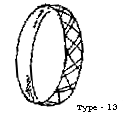 |
 |
Type-XIV ---
The next group of ring containing only one in number is a thin rectangle cross section type plain in outer surface. The three sides are devoid of any engravings but one side is provided with designs which are made of small parallel lines separated at equi-distant intervals.
|
| Type-XV --–
The next group contains only one ring with rectangular cross section. The upper portion is plain but only four knobs are seen at four sides of the upper surface.
|
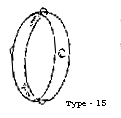
|
In the rings there is found a general trend of development when closely viewed. The concentric circular design found adapted on the double plated top (Type-II) of the rings is again adapted on the four plated top of the ring in the Type-V exhibiting gradual maturity in skill and sense of proportion by the Juang artist. Similarly the S plated pattern Type-VIII is seen developed into the Type-III pattern wherein three knobs triangularly placed at the fag end of the concentric circular end of S or Loop. The skill is again adapted with further modification of the top in the two attached side to side flower designs made on a plate. The dotted knob provision is seen as repeated in Type-III pattern with circular placement round a prominent central knob. The parallel circle reminds the earlier skill attached to the bell in Type-I. The hearing bone design found in Type-VI is further modified in Type-VII where there is further elaboration in decoration by adding two more parallel lines on both the sides of the design and further addition of a string or wire to the earlier design. The types from I to IX indicate the inception of the filigree work design elaborately practiced in Cuttack. But it is difficult in the present state of our knowledge to tell whether these designs have been borrowed from tribal inhabited hills or plains around Cuttack or the latter adopted and developed it from Juang workmanship and skill. However, there is a string of relationship existing between the two. The knob design adopted on the rings is very old pattern found on the pre and early historic pottery decorations of Orissa. So it can be surmised that the knob and string pattern of the rings might be the earlier cultural patterns. As such, the filigree work pattern of Cuttack might be borrowed from Juang art.
Anklet:
The anklets found used by the Juang dancers contain another aspect of their art depiction. There are two varieties of the same.
| Type-XVI ---
Hollow tubular form. This piece is hollow tubular round shaped from with plain ends facing each other. The upper surface is provided with interlocking hooks to make room for the attachment of bells. The anklet has two faces, i.e. obverse and the reverse. The reverses plain with parallel line decorations. Two parallel lines are drawn across to mark the end-faces of the rounded forms. These two lines are shown cut horizontally with smaller lines equidistant from each other to make a design. There is a slight opening in the inner face remaining close to the wearer's leg. But the obverse face is provided with engraved designs. On the surface denticulate triangular forms are engraved in a line flanked by two demarcating parallel lines extending from end-face to end-face a little equidistant from both the sided-rims. The outer-rim surface of the anklet is seen decorated with parallel lines drawn in the middle are divided with smaller lines cut across equidistant from each other. The inter-locking hook type attachments with intervals are provided on this apportioned parallel lines almost equidistant from each other wherein bells are attached. The bells are prototypes of the earlier mentioned ones in Type-I rings indicating the link in the workmanship of the ring and the anklet. But the mouthed ends of the anklet is solid and closed.
|
 |
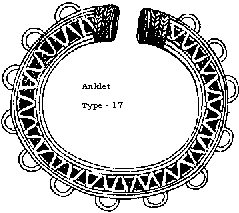 |
Type-XVII ---
This is again a hollowed tubular anklet with denticulated jafri-patterned decoration in both the faces with rings type attachments on the upper rim surface meant for the bells. Since the specimen has lost all the bells it can only be contemplated that the bells might be containing inter locking hook arrangements. The end faces are provided with decorations. It contains wider and flared ends than the other portions of the tube. Form the last reaches of the jafri design cut on the tubular giving a thorough gaze to the other side of the anklet revealing parallel lines, five in number, which are drawn across towards the end of the end faces.
The inner space of these parallel lines are provided with ‘V’ pattern engraved in a reversed number. The upper rim surface which remain outside when the anklet is worn provide parallel lined engravings only with type attachments for the bells at equal intervals. The mouth portion of the tubular anklet is kept open.The workmanship is just the continuation of the art designs provided in Type-XVI and Type-X patterns. Again, the Jafri-pattern reminds us of a primitive filigree work type that could have been imitated in the silver metal.
|
The Juang artists have lost their tradition due to the onslaught of the so called modernity and the disdainful attitude towards their cultural products. But their contribution has already become a part of the great Orissan art tradition and received world wide acclaim. The revival of this art form will actually preserve the tribal culture and embolden them to boast of their rich tradition.
|

